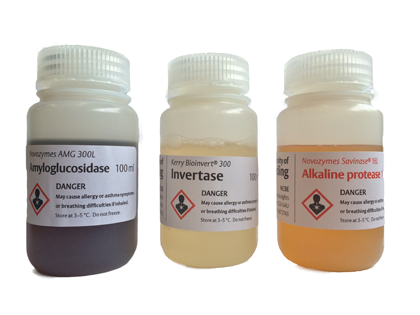SAFETY: Working with enzymes

The following advice is a brief summary of essential safety guidelines. More detailed information is available in a new chapter from ‘Topics in Safety’, published by the ASE which can be downloaded from the link below. Additional guidance is given in the Safety Data Sheets supplied with individual enzyme products or can be found on the safety data sheets page.
HAZARDS FROM ENZYMES
There are two principal hazards from enzymes. Firstly, some enzymes may directly affect human tissues. For example, a protease, splashed into the eye or entering the skin through a cut or scratch may break down proteins and cause serious damage or irritation. Secondly, all enzymes have the potential to trigger an allergic reaction in susceptible individuals, usually through inhalation of enzyme-containing dust or an aerosol.
NEW SAFETY SYMBOLS AND HAZARD STATEMENTS
You may know that the safety hazard pictograms and warnings on chemicals throughout the European Union have recently changed.
The new label on all our liquid enzyme products carries the words: DANGER. May cause allergy or asthma symptoms or breathing difficulties if inhaled.
While this may appear alarming, the hazards associated with the enzyme products have not changed.
It is important to note that there is only a hazard from the product if it is inhaled. This is extremely unlikely to occur in an educational context where small volumes of enzyme are used, often in a very dilute form, or mixed with a larger volume of substrate solution. (Smelling the product is unlikely to be hazardous.)
The hazard warning is more relevant in an industrial context, where large volumes of enzyme may be used and workers may be exposed repeatedly to aerosols of the enzyme product, which could be breathed in.
That said, it is wise to ensure that enzyme dust or aerosols are not produced when handling the enzyme product. This is easy to do.
DO NOT LET ENZYME PRODUCTS DRY UP
If liquid enzymes are allowed to dry up, there is a risk of dust formation. In susceptible people the repeated inhalation of dust may provoke asthma or hayfever-like symptoms.
That is why any spill should be rinsed with water — straight away.
AVOID THE FORMATION OF AEROSOLS
If enzyme-containing aerosols are formed, there is a risk of inhalation of the enzyme. In susceptible people the repeated inhalation of an aerosol may provoke asthma or hayfever-like symptoms.
That is why enzymes should never be sprayed.
AVOID DIRECT SKIN AND EYE CONTACT
If, by accident, you get liquid enzyme on your skin or in your eyes, the remedy is plenty of tap water — quickly. Enzymes are soluble in water, so contaminated clothing can be washed in water as usual.
This action will generally prove sufficient, but if symptoms develop in the respiratory passages, on the skin or in the eyes, see a doctor immediately.
Refer to the Safety Data Sheets that accompany the enzyme products for further information.

